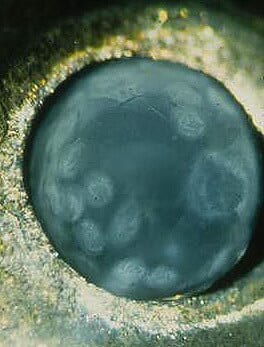
The classic outbreak of eye fluke causes cataract in affected fish leading to visual impairment and, ultimately, blindness resulting in affected fish becoming dark, unable to feed, losing condition and having an increased susceptibility to predation. This has always been the recognised condition associated with eye fluke infestation and has in the past been responsible for significant levels of blindness and loss in affected fish. There is, however, another 'syndrome' associated with infestation with eye fluke which can have much more acute and, in my experience, much more devastating consequences for the farmer. This syndrome, probably best described as 'acute cercarial attack' is a consequence of a massive invasion of larval parasites into the body of the fish causing amazingly severe pathology and damage.

The eye fluke has a complex life cycle with a water snail (Lymnaea) acting as one of the intermediate hosts. Larval parasites - cercariae - are released from the snails and actively seek out fish which act as the second intermediate host and it is this invasion of cercariae which can cause such extensive damage in the fish. The snails can release millions of cercariae over a very short period of time resulting in an overwhelming invasion of the fish. The cercariae mostly penetrate through the flank of the fish, often along the lateral line and this can be seen grossly as extensive haemorrhagic lesions and, if you run your finger over the flank of the fish you can feel a rough, sandpaper-like, effect where the parasites enter the skin.
Quite frequently a farmer will see fish affected with an acute haemorrhagic syndrome and assume it is a serious bacterial infection and some outbreaks have certainly been mistaken for bacterial disease in the past. On it's migration through the tissues of the fish to it's final destination in the eye, the parasites cause severe damage and this results in the affected fish swimming abnormally (often side swimming), becoming dark, lethargic, off their food and often rapidly developing serious spinal deformities. There is a rapid escalation of fish losses due to this extensive tissue damage. The parasites move quickly through the fish to the eye and the microscopic examination of fresh eye squashes will show high levels of the fluke - in fact, if you still have good eyesight yourself, the flukes are visible to the naked eye when you squash a fish eye onto a microscope slide. Surviving fish are often in a very poor state, susceptible to secondary fungal and bacterial disease and frequently totally blind.
It is this 'acute cercarial attack' syndrome which was experienced in 2005. Similar outbreaks have been seen in other years but nothing to match the scale of the 2005 outbreaks where farms with no history of fluke suffered severe outbreaks of the infestation.
Why 2005 was particularly bad is still a bit of a mystery but the Spring had been particularly dry with very little rainfall and very low rivers. Snail populations appeared to be high in some of these rivers and there were been no spate conditions to wash snails down river and away from the farms. There may well therefore have been a concentration of infested snails - possibly building on the long dry summer of 2004 - and warm, dry conditions would be ideal for high levels of cercarial release invading vulnerable farms.
The final host is a piscivorous bird which predates on the infested fish and gulls are often implicated in contaminating waters upstream with the parasites and completing the lifecycle. There is little doubt that gull populations inland have increased (thought to be caused by reduced access to food at sea due to a decline in our fishing industry - but that's another story) and there is a possibility that an increase in the fluke's final host numbers contributed to the problems experienced. No doubt, as with many other fish diseases, the answer is a combination of environmental and biological factors which favoured the parasite at the cost of the host.
Control of this parasite can be difficult. Exclusion of birds from the farm and control of snail populations (e.g. by vegetation control) can help, but this is easier said than done. The parasite can cycle in wild populations of fish up stream from the farms and the cercariae can survive for at least 24 hours and so it is quite possible that farms can be vulnerable to infestation even if the reservoirs of parasites are some way upstream.
Filtration of incoming water to exclude the cercariae is possible, but the screens must be of small enough mesh to keep out the parasites and this may have serious implications on intake volume and fish production.
So, cercarial attack can be a very serious problem and any farmer experiencing skin lesions and a haemorrhagic syndrome which looks like a bacterial septicaemia should be considering eye fluke invasion as a possible cause. I'm convinced that some conditions reported in the past which present as mysterious skin lesions - 'grey sheen' and possibly even some of the lesions reported as 'strawberry disease' may have had eye fluke as the true cause.
Source: Fish Vet Group - March 2006


